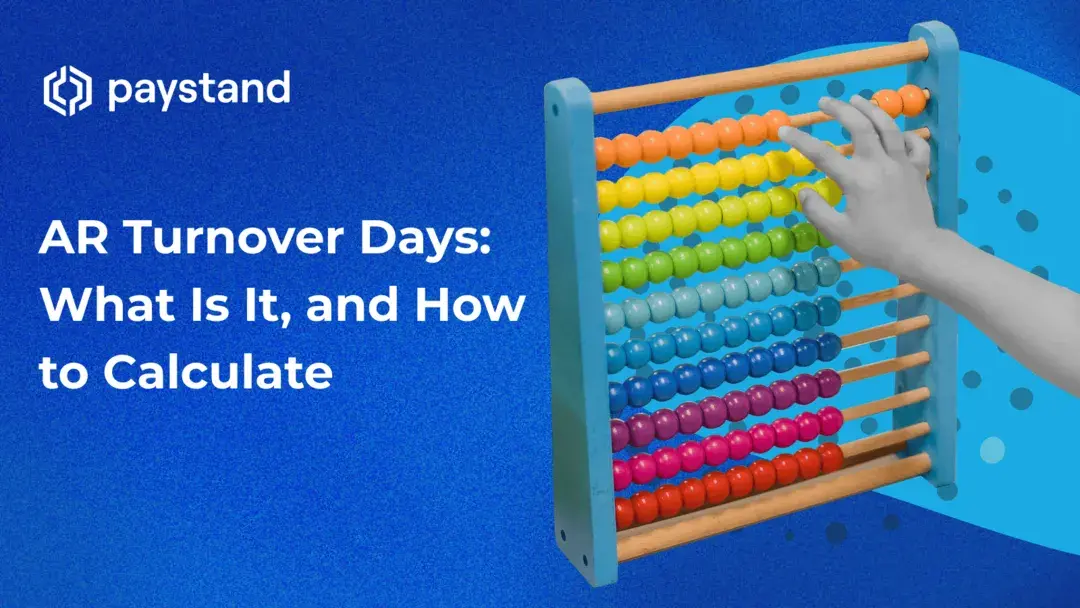AR Turnover Days: What Is It and How to Know What Is a Good Ratio?

As an AR manager, you must know what AR Turnover Days are and their importance as a metric. They're used to evaluate how efficiently accounts receivable are managed by measuring the average number of days it takes for a company to collect payments from its customers.
Efficient AR turnover days management is vital for healthy cash flow and business operations. By understanding this metric, businesses can improve their financial performance and ensure timely collections. Keep on reading and become the AR Management hero your business needs.
Why Are AR Turnover Days Important?
AR turnover days hold great significance for businesses. They offer valuable financial health, liquidity, and operational efficiency insights.
One of the main reasons this metric is crucial is its direct impact on a company's liquidity. Fast collections mean quicker access to cash, which is vital for day-to-day expenses, investing in growth, and fulfilling financial obligations.
Low turnover days mean a company efficiently collects payments, maintaining a healthy cash flow. High turnover days suggest delays in collections, straining liquidity, and hindering the ability to cover financial needs.
AR turnover days provide valuable insights into a company's cash conversion cycle efficiency. It helps identify bottlenecks and enforce strategies to streamline processes, reduce payment delays, and improve cash flow. This helps optimize working capital and enhance financial stability.
How to Calculate AR Turnover Days?
Calculating AR turnover days is essential for businesses. It measures the efficiency of their collection process and how fast they convert credit sales into cash. It also reflects accounts receivable management effectiveness and helps businesses make informed decisions to improve cash flow and financial performance.
Here's a step-by-step guide to calculating AR turnover days:
-
Determine the Accounts Receivable Balance. Identify the accounts receivable balance at the beginning and end of the period you want to calculate the turnover days.
-
Calculate the Average Accounts Receivable. Next, calculate the average accounts receivable by adding the beginning and ending balances and dividing the sum by two.
Average Accounts Receivable= Beginning Accounts Receivable+Ending Accounts Receivable
2 -
Determine the Net Credit Sales. Net credit sales represent the period's total sales made on credit, excluding returns, allowances, and discounts.
-
Calculate the Accounts Receivable Turnover Ratio. The accounts receivable turnover ratio is calculated by dividing the net credit sales by the average accounts receivable.
Accounts Receivable Turnover Ratio= Average Accounts Receivable
Net Credit Sales -
Convert the Turnover Ratio to Days. Finally, convert the accounts receivable turnover ratio into days by dividing 365 by the turnover ratio. This provides the average number of days it takes for the company to collect its accounts receivable.
Accounts Receivable Turnover Days= 365
Accounts Receivable Turnover Ratio
Once you calculate the AR turnover days, analyze the results. Consider your business' operation context, industry benchmarks, and historical data. A low turnover value indicates fast payment collection and efficient accounts receivable management. A high turnover value suggests collection delays, which may need further analysis to identify underlying issues and implement corrective measures.
How to Improve Accounts Receivable Turnover?
To improve accounts receivable turnover, consider implementing the following strategies:
Streamline Invoicing Processes
Streamlining invoicing processes is essential for ensuring quick and accurate billing. Businesses can streamline their invoicing processes by:
- Implementing automated invoicing systems to generate invoices promptly and accurately.
- Sending invoices electronically to customers for faster delivery and processing.
- Including clear payment terms, due dates, and instructions for easy understanding and compliance.
Offer Discounts for Early Payments
Offering early payment discounts incentivizes customers to settle their invoices promptly. Businesses can provide various types of discounts, such as:
- Early payment discounts. Offer a discount on the invoice amount for payments made within a specified timeframe (e.g., a 2% discount for payments made within ten days).
- Volume discounts. Offer discounts to customers who purchase in bulk or meet certain purchasing thresholds.
Effective Credit Policies
Effective credit policies are crucial for managing credit risk and ensuring customer payments. Businesses can establish clear and consistent credit policies by:
- Conducting thorough credit checks on new customers to assess their creditworthiness and payment history.
- Setting credit limits based on customers' creditworthiness, payment history, and financial stability.
- Strict payment terms and penalties for late payments to encourage prompt invoice payments.
Follow Up on Overdue Invoices
Following up on overdue invoices is essential for addressing payment delays and speeding up collections. Businesses can follow up on overdue invoices by:
- Sending reminders to customers before the upcoming payment due date.
- Following up on overdue invoices with personalized communication, such as phone calls or emails, to resolve any issues.
- Offering flexible payment options or plans to help customers with financial difficulties.
Common Mistakes to Avoid
Overlooking Overdue Invoices
One of the most common mistakes businesses make is overlooking overdue invoices. Failing to follow up on unpaid invoices can lead to payment delays, increase bad debt risk, and harm cash flow. Businesses must track and follow up on overdue invoices. This ensures timely resolution and collection of outstanding payments.
Ignoring Customer Creditworthiness
Another critical mistake is ignoring customer creditworthiness when extending credit terms. Failing to check customers' payment history and financial stability can lead to late or non-payments. Businesses must establish clear credit policies, conduct credit assessments on new customers, and set appropriate credit limits based on risk assessment to mitigate credit-related risks.
Failing to Follow Up on Unpaid Invoices
Not following up on unpaid invoices can lead to payment delays and cash flow challenges. Consistent follow-up ensures addressing unpaid invoices promptly, increasing the chances of successful collections.
Ineffective Communication
Poor customer communication about payment terms, due dates, and expectations can contribute to challenges in accounts receivable. Businesses must ensure clear communication about invoices, payment options, and consequences of late payments. Effective communication helps establish mutual understanding and encourages timely payment from customers.
This becomes crucial with accounts receivable outsourcing. Maintaining consistent and transparent communication with the outsourcing partner is essential to ensure your policies and objectives align to optimize the accounts receivable effectiveness.
Lack of Automation and Technology
Manual processes for accounts receivable management can hinder efficiency and lead to errors. Businesses should leverage automated solutions, like Paystand, to streamline invoicing, payment processing, and collections. This reduces manual intervention, speeds up processes, and improves accuracy, enhancing AR turnover days and cash flow management.
When implementing these improvements, always consider having a clear accounts receivable flowchart or implementing AR automation software. This ensures seamless execution of strategies and enhances efficiency in managing receivables, ultimately contributing to a healthier cash flow and improved financial performance.
By monitoring AR turnover days and comparing them to industry standards and historical trends, businesses can identify areas for improvement, optimize their collections process, and enhance financial performance.
Moreover, AR turnover days are an indicator for investors and financial institutions. A consistently low turnover value shows strong management practices, instilling confidence in the company's financial health.






